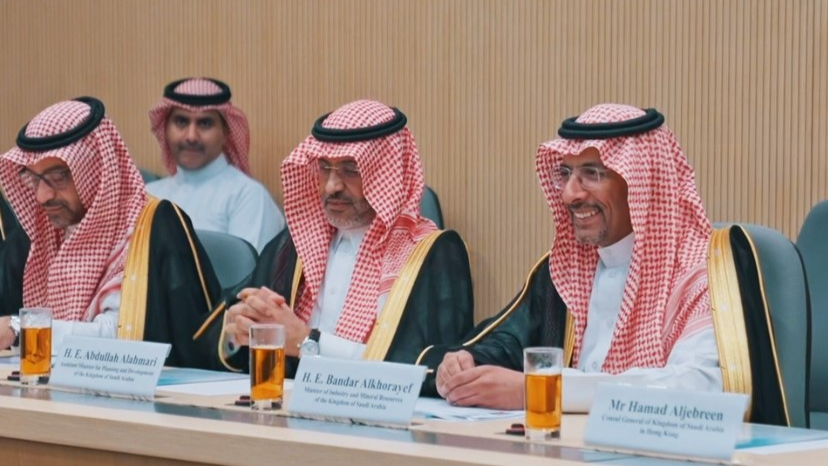Minister promotes Saudi Arabia as manufacturing base, ties in mineral resources, advanced tech

Saudi Arabia is eyeing greater collaboration with major economies in East Asia as it seeks to boost research and development, as well as innovation, within the kingdom, with China a key focus for partnerships, especially in sectors such as mineral resources, automobiles and advanced technologies.
The plans are part of Saudi Arabia’s grand economic diversification plan, Vision 2030, which was unveiled by Saudi Crown Prince Mohammed bin Salman Al Saud in 2016 and includes mining as the third pillar of national industrialism. One of the biggest oil producers in the Middle East, the country’s mineral wealth is estimated at $2.5 trillion.
In an interview with China Daily, Saudi Minister of Industry and Mineral Resources Bandar Bin Ibrahim Alkhorayef said his country can complement East Asia by helping Asian enterprises to relocate some manufacturing operations to Saudi Arabia through cooperation in R&D and innovation.
“There’re a lot of commonalities between the two regions, and (one of) Saudi Arabia’s ambitions is to grow its manufacturing base to explore its mining capabilities. This is not just to satisfy our local market, but also to participate in the global market,” he said.
“We’ve all seen the challenges of supply chain disruptions. We believe Saudi Arabia can be a great place to solve these problems.”
Alkhorayef had earlier wrapped up what he called an “overwhelming” visit to the Guangdong-Hong Kong-Macao Greater Bay Area after a week-long tour of Asia, including Singapore, where he said the aim was to encourage businesses to look to Saudi Arabia as their next production base.
The minister had visited the Chinese mainland almost exactly a year ago, holding talks with ministers and officials and touring companies and factories.
“China is a big country. The last time, we visited five cities, and this time we went to Guangzhou. There’s a different flavor in each one of these cities and we try to capture the value and what each region in China can offer to Saudi Arabia,” said Alkhorayef.
“Our aim is to focus on two areas. One is to help large players look to Saudi Arabia as their next production or logistics location because we can offer a great location (with) a mixture of enablers — from raw materials to energy prices and infrastructure.”
The other aspect, which he calls “interesting”, is innovation and the adaptation of new business models, such as “Industry 4.0” and “Industry 5.0”, plus artificial intelligence, apart from manufacturing. “This is where we see a lot of opportunities for collaboration.”
“Industry 4.0” or “The Fourth Industrial Revolution”, is defined by The World Economic Forum as the next phase of manufacturing, characterized by smart technologies and automation that will allow manufacturers to produce goods more efficiently, quickly, cheaply and sustainably. “Industry 5.0” is an emerging phase that sees machines working alongside humans to enhance workplace processes sustainably.
During his latest tour of the Chinese mainland, Alkhorayef invited companies there to invest in Saudi Arabia, as he participated in a roundtable meeting organized by the Federation of Chambers of Commerce in Guangdong’s provincial capital, Guangzhou.
In the Hong Kong Special Administrative Region, he met the secretary for commerce and economic development, the director of the Trade and Industry Department, and officials of the Innovation and Technology Commission, according to the Saudi Press Agency.
China is Saudi Arabia’s largest trading partner. The Saudi Ministry of Finance has said that trade between the two countries exceeded $100 billion last year.
According to official Saudi data released in February this year, China is the main destination for Saudi exports, accounting for 13.2 percent of exports. China also ranks first in terms of the kingdom’s imports, taking up 19.9 percent of total imports.
Saudi Arabia enacted a mining investment law in 2021 to ensure that mining activities contribute to community development, generate new job opportunities, and support the growth of local businesses.
Alkhorayef said his ministry has identified 12 sectors as priorities in the country’s transformation plans, and that some of them are “related to our national security, like food security, pharmaceuticals, water security and defense”.
“The other products are related to capturing added value from our natural resources in oil and gas, petrochemicals, minerals, downstream chemicals and the processing of minerals.”
Another focus is future industries like the manufacturing of electric vehicles, aerospace and, generally, new technologies emerging in the future and “we want to be ready for that”, the minister said.
“We believe Saudi Arabia can offer many opportunities for global players from various countries,” he said, adding: “China is Saudi Arabia’s top trading partner. It’s logical we should find areas for collaboration.”
As for China’s Belt and Road Initiative, Alkhorayef stressed that Saudi Arabia is located in an area where it can help to link up many other regions. “Definitely we’re in a position to allow us to access markets that are growing and have high potential for growth.”


